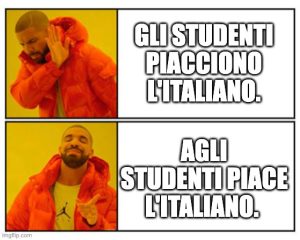G 8.1 Piacere
Piacere
Piacere è un verbo fondamentale nella lingua italiana. Funziona diversamente di quasi tutti i verbi, ma nel futuro imparerete che ci sono altri verbi come “mancare a”, “servire a” e “bastare a” che seguono lo stesso schema di “piacere a”.
Quando usi il verbo piacere, fai una piccola pausa e rifletti sui punti seguenti:
What is different about the subject of piacere? Do we, as subjects, perform “liking” or are we merely objects of our pleasure?
For example, take the typical English construction: Giacomo likes apples. Rephrase it, slightly awkwardly, in English: Apples are pleasing to Giacomo. By rethinking it *first* in English, you can stress that the apples are the subject of the verb, while Giacomo is just an indirect object.
Now rewrite it in Italian:
Le mele (plural subject) piacciono (plural verb) a Giacomo (indirect object).
That plural verb can be transformed to simple past (passato prossimo):
A Giacomo le mele sono piaciute.* (‘piaciute’ finisce in ‘e’ perchè le mele sono femminili e plurali).
or to the imperfect (imperfetto):
Le mele piacevano a Giacomo
NB: with piacere, get used to seeing the form of the verb in 3rd person singular and plural forms.
| WHEN | WHAT PLEASES? | |
| Something singular | Something plural | |
| Presente | piace | piacciono |
| Imperfetto | piaceva | piacevano |
| Passato prossimo | è piaciuto (il panino)
è piaciuta (la mela) |
sono piaciuti (i panini)
sono piaciute (le mele) |
Quando non usi un pronome di oggetto indiretto con piacere e vuoi includere il nome o il titolo di qualcuno, è necessario includere la preposizione “A” per non cambiare il significato della frase drasticamente.

Es:
Alla professoressa piace leggere.
A Martino piacciono i romanzi.
Agli studenti piace l’italiano.
I Longhorns piacciono ai miei amici.
A Drake piace quando gli studenti usano bene il verbo piacere.
Prova ad allenarti qui:

